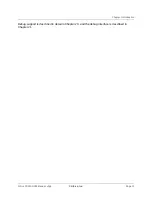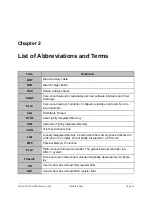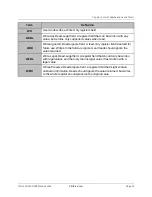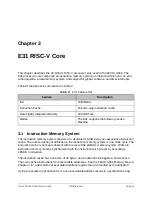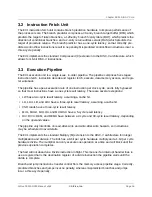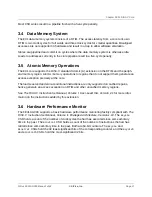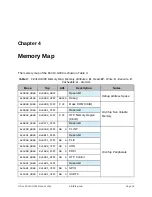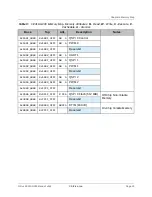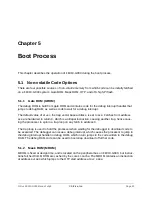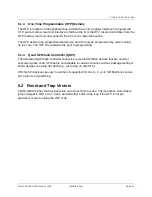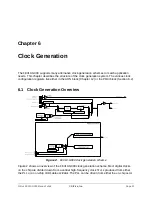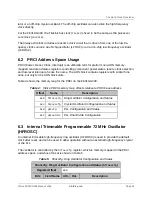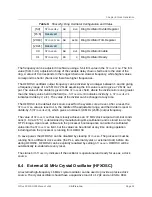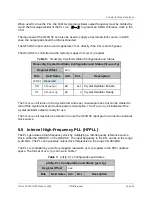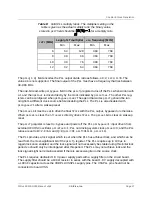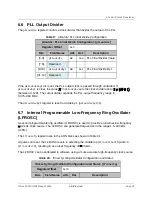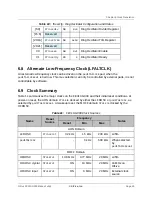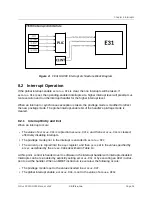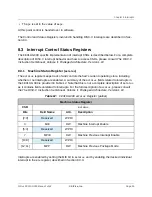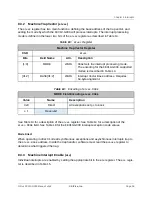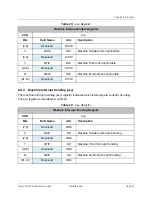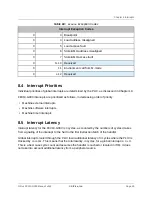
[5:0]
hfroscdiv
RW
0x4
Ring Oscillator Divider Register
[15:6]
Reserved
[20:16]
hfrosctrim
RW
0x10
Ring Oscillator Trim Register
[29:21]
Reserved
30
hfroscen
RW
0x1
Ring Oscillator Enable
31
hfroscrdy
RO
X
Ring Oscillator Ready
The frequency can be adjusted in software using a 5-bit trim value in the
hfrosctrim
. The trim
value (from 0–31) adjusts which tap of the variable delay chain is fed back to the start of the
ring. A value of 0 corresponds to the longest chain and slowest frequency, while higher values
correspond to shorter chains and therefore higher frequencies.
The HFROSC oscillator output frequency can be divided by an integer between 1 and 64 giving
a frequency range of 1.125 MHz–72 MHz assuming the trim value is set to give a 72 MHz out-
put. The value of the divider is given in the
hfroscdiv
field, where the divide ratio is one greater
than the binary value held in the field (i.e.,
hfroscdiv
=0 indicates divide by 1,
hfroscdiv
=1
indicates divide by 2, etc.). The value of the divider can be changed at any time.
The HFROSC is the default clock source used for the system core at reset. After a reset, the
hfrosctrim
value is reset to 16, the middle of the adjustable range, and the divider is reset to
divide-by-5 (
hfroscdiv
=4), which gives a nominal 13.8 MHz (±50%) output frequency.
The value of
hfrosctrim
that most closely achieves an 72 MHz clock output at nominal condi-
tions (1.8 V at 25 °C) is determined by manufacturing-time calibration and is stored in on-chip
OTP storage. Upon reset, software in the processor boot sequence can write the calibrated
value into the
hfrosctrim
field, but the value can be altered at any time during operation
including when the processor is running from HFROSC.
To save power, the HFROSC can be disabled by clearing
hfroscen
. The processor must be
running from a different clock source (the PLL, external crystal, or external clock) before dis-
abling HFROSC. HFROSC can be explicitly renabled by setting
hfroscen
. HFROSC will be
automatically re-enabled at every reset.
The status bit
hfroscrdy
indicates if the oscillator is operational and ready for use as a clock
source.
6.4
External 16 MHz Crystal Oscillator (HFXOSC)
An external high-frequency 16 MHz crystal oscillator can be used to provide a precise clock
source. The crystal oscillator should have a capacitive load of ≤ 12 pF and an ESR ≤ 80 Ω.
Table 5:
hfrosccfg: Ring Oscillator Configuration and Status
Chapter 6 Clock Generation
SiFive FE310-G000 Manual: v3p2
© SiFive, Inc.
Page 24



